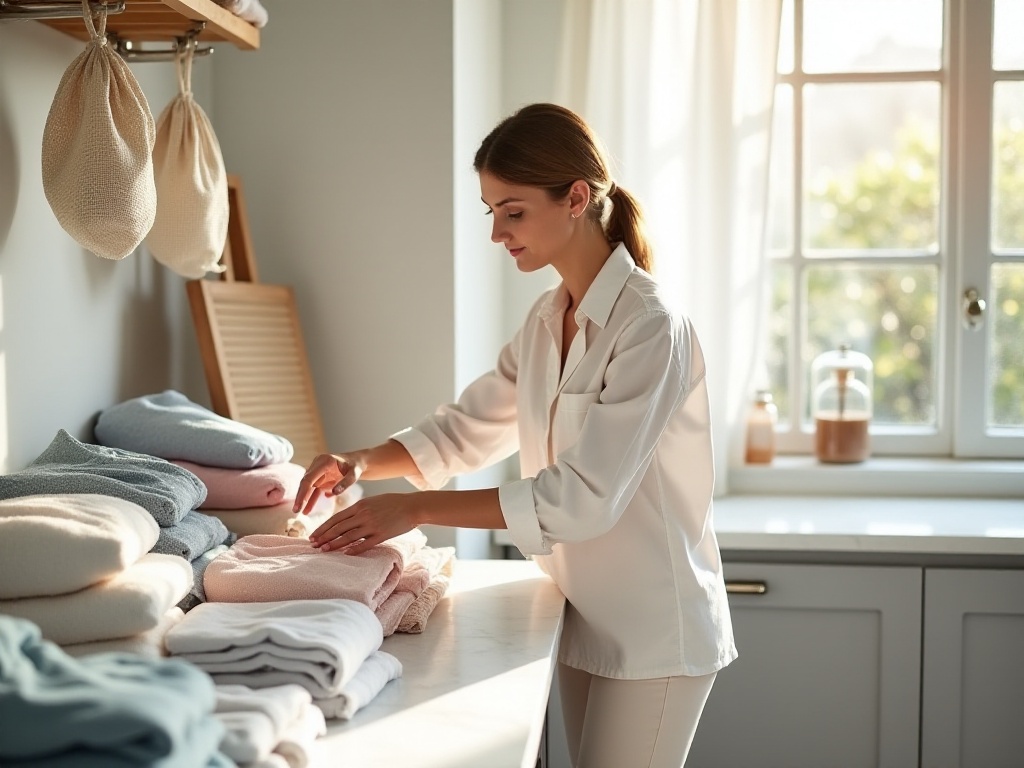Opening Thoughts
Have you ever experienced situations like these: your new clothes fade after just a few wears, an expensive wool sweater shrinks to a size only your niece can wear, or your shirts always come out wrinkled and unsightly after washing? Actually, these problems aren't hard to solve - the key is mastering the correct washing methods.
As someone who once shrunk a cashmere sweater into doll-size clothing, I deeply understand how much damage improper washing methods can cause to clothes. I remember that cashmere sweater was quite expensive, but due to my ignorance, I threw it directly into the washing machine on high heat. When I took it out, it had shrunk beyond recognition. Looking at the deformed cashmere sweater, my heart was broken. This incident taught me a profound lesson and prompted me to seriously study proper clothing care and maintenance methods.
After years of exploration and learning, I've developed a set of practical clothing washing and care methods. To be honest, at first I also thought washing clothes was just a matter of adding some detergent and pressing a button. But as I continued to experiment and learn, I discovered that clothing care is actually quite a profound subject. Today I'll share my experience with everyone, hoping to help you avoid the pitfalls I once fell into.
Basic Preparation
First, let's talk about sorting. You might think, it's just washing clothes, does it really need to be this particular? But this step is actually very important. I've seen people wash white T-shirts together with dark jeans, resulting in the white T-shirts turning blue. Such painful lessons teach us that proper sorting is the first step in clothes washing.
Speaking of sorting, first is by color. White clothes are the easiest to get stained, so they must be washed separately. Light-colored clothes like beige, light pink, light blue, etc. can be washed together. Dark-colored clothes, especially newly purchased dark clothes, should also be washed separately because they tend to bleed color.
Fabric sorting is also important. Delicate silks and wools absolutely cannot be washed together with rough denim and canvas. I once got lazy and washed a silk shirt with jeans, resulting in the silk shirt getting several tears from the jeans' metal buttons.
Sorting by degree of soiling shouldn't be ignored either. Especially dirty clothes, like post-workout clothes or those with stubborn stains like oil or soy sauce, should be washed separately. This not only better handles the stains but also prevents them from transferring to other clothes.
My current habit is to prepare three laundry baskets for white, light, and dark-colored clothes. Within each color group, I further sort by fabric and degree of soiling. Although this might seem troublesome, it effectively protects clothes and helps them maintain a longer useful life.

Pre-wash Check
Before each wash, I've developed good checking habits. First, check the care label - this is really important. I once ruined a "dry clean only" wool coat by throwing it directly into the washing machine because I didn't check the label. The coat not only shrunk but completely lost its shape and became unwearable. That coat cost me nearly two thousand yuan, and it was just ruined - thinking about it still hurts.
Since then, I've become almost obsessive about care labels. Every time I buy new clothes, I carefully study their care labels. The symbols on care labels might look complicated, but they're not actually hard to understand. For example, a basin with 30° means the water temperature shouldn't exceed 30 degrees; a crossed-out iron means no ironing; a circle with the letter P means dry clean only.
Remember to check pockets. Once I forgot to check and ended up washing an important receipt and several hundred yuan together. The money was still usable after drying, but the receipt was completely blurred, making expense claims very troublesome. Since then, I carefully check all pockets every time - it's become instinctive. Not just pants pockets, but jacket pockets and shirt pockets too. Sometimes you find unexpected things, like forgotten change, shopping receipts, and even chewing gum.
Besides checking pockets, it's important to check for any damage to the clothes. If you find loose threads or small holes, it's best to fix them before washing. During machine washing, these small problems can become big ones. I once ignored a small hole, and after washing, it had become huge - I eventually had to find a tailor to repair it.
For clothes with special decorations, like sequins, beads, or embroidery, special attention is needed. These decorations might fall off or get damaged during washing. I usually wash these clothes inside out, which helps protect the decorations to some extent. If the decorations are particularly delicate or easily damaged, it's safer to have them dry cleaned.

Everyday Clothes
Regarding T-shirts, many people might think you can wash them any way you like. But actually, washing T-shirts in cold water can help maintain their elasticity and color longer. In my own experiment with two identical T-shirts, one washed in cold water and one in hot water, the cold-washed one still looks like new, while the hot-washed one has yellowed and lost shape.
When washing T-shirts, I suggest turning them inside out to protect patterns and prints. For white T-shirts, you can add some bleach during washing, but make sure to check whether it's chlorine bleach or oxygen bleach. While chlorine bleach has better whitening effects, using too much can damage the fabric and isn't very environmentally friendly. I recommend using oxygen bleach - although the effect isn't as immediate as chlorine bleach, it's gentler and causes less damage to clothes.
Jeans washing also requires attention. It's recommended to wash them inside out to prevent fading. Also, you don't need to wash them after every wear unless they're particularly dirty. My current habit is to wash them every 3-4 wears, which is both environmentally friendly and extends the life of the jeans. However, note that if the weather is particularly hot or you've been exercising and sweating, you should wash them promptly.
For jeans washing temperature, it's best to use cold or warm water, avoiding hot water. Hot water accelerates denim fading and might cause shrinkage. Detergent choice is also important - it's best to choose specialized denim detergent, which usually contains special color-protecting ingredients that can slow down denim fading.
Regarding shirts, many people struggle with their tendency to wrinkle. Actually, this problem isn't hard to solve if you master the correct washing method. First, shirts are best hand-washed, especially expensive ones. If you really don't have time to hand wash, when using the washing machine, select the gentle cycle and make sure all buttons are fastened to prevent them from being torn off during washing.
Post-wash handling of shirts is also important. Don't hang wet shirts directly on hangers, as this can cause deformation and leave hanger marks on the shoulders. The correct method is to gently absorb excess water with a towel, then fasten all buttons, arrange the collar and cuffs properly, and then hang to dry. If possible, it's best to start ironing when the shirt is half-dry, as this is easier than ironing completely dry shirts.
Athletic wear cleaning also needs special attention. Many athletic clothes use special functional fabrics, like quick-dry or waterproof materials. These fabrics might lose their functionality if washed with regular detergent. It's recommended to use specialized athletic wear detergent, and best to avoid fabric softener as it can clog fabric fibers and affect their breathability and moisture-wicking properties.
Delicate Items
For delicate fabrics like silk and lace, never just throw them in the washing machine. I use gentle detergent and wash them carefully by hand. Remember to use cool water - high temperatures will damage the fabric. After washing, lay them flat on a towel to dry to maintain their shape.
Silk garment cleaning requires the most patience. First, prepare specialized silk detergent, as regular laundry detergent might damage silk fibers. Water temperature must be kept below 30 degrees; I usually use room temperature water. Washing must be very gentle - don't rub forcefully. It's best to soak silk garments in soapy water and gently press to let water flow through the fabric.
Never wring silk garments, as this will destroy the fiber structure. The correct method is to wrap the garment in a clean towel and gently press to absorb water. When drying, avoid direct sunlight - it's best to dry in a cool, ventilated place. For silk shirts or dresses, I recommend hanging them to dry to reduce wrinkles.
Lace items also need extra care. Lace patterns are delicate and complex, easily deforming or breaking during washing. I suggest putting lace items in special laundry mesh bags, which protects the lace from getting caught on other clothes. For items with lace decorations, pay special attention to the lace parts during washing - gentle pressing is better than rubbing.
Wool sweater washing is also a skilled task. Many people have experienced shrinking wool sweaters, but with the correct method, wool sweaters can definitely be washed at home. First, choose specialized wool detergent, which is usually gentler and contains wool fiber care ingredients. Water temperature must be kept below 30 degrees, preferably cool water, as high temperatures cause wool fibers to contract.
Wool sweaters shouldn't be soaked for long periods - 5-10 minutes of washing is usually enough. Wash by gently pressing, not rubbing or wringing. When drying, it's best to lay flat rather than hanging, as wet wool sweaters easily stretch and deform on hangers. If you're in a hurry to wear it, you can wrap the sweater in a towel and gently press to absorb water, but absolutely never use a dryer as it will definitely cause shrinkage.
Regarding cashmere sweaters, their washing requirements are even stricter than regular wool sweaters. Cashmere fibers are finer and softer than wool, so they're more easily damaged. I recommend dry cleaning, but if you must wash at home, definitely use specialized cashmere detergent and be extra gentle. After washing, don't wring dry - absorb water with a towel and lay flat to dry, occasionally adjusting the shape during drying to maintain the sweater's fit.

Care Tips
Many garments actually don't need to be washed with water every time. For items like suit jackets and wool coats, I use a steam iron. It not only removes wrinkles but also eliminates odors, which is particularly convenient.
The steam iron is really my secret weapon, especially for clothes that shouldn't be frequently washed with water. When using the steam iron, be careful to maintain an appropriate distance - don't let the steam nozzle directly contact the garment. I usually hang the garment and steam evenly from top to bottom while gently smoothing out wrinkles by hand. This method not only removes wrinkles but also refreshes the garment and eliminates odors.
For suits and formal wear, besides regular dry cleaning, daily care is also important. After each wear, gently brush with a clothing brush to remove surface dust. For small stains, use professional spot cleaner for local treatment. When hanging, choose specialized suit hangers - regular thin hangers might leave marks on the shoulders.
If clothes have pilling, use a fabric shaver. I bought a professional fabric shaver earlier, and it works really well - it gave new life to several sweaters that were almost ready for disposal. When using the fabric shaver, be careful with pressure - don't press too hard to avoid damaging the fabric. I usually lay the garment flat on a table and gently remove pills with the shaver.
Moth prevention is also an important aspect of clothing care, especially when storing clothes between seasons. I put some natural moth repellents in the closet, like lavender sachets or camphor balls. These not only prevent moths but also keep clothes smelling fresh. However, note that while mothballs are effective at preventing moths, their smell is too strong and they can affect human health, so I don't use them anymore.
Regular closet organization is also a good method for clothing care. I thoroughly clean out my closet each season, storing away rarely worn clothes to make space for frequently worn items. When storing, make sure clothes are clean and preferably spray with specialized clothing freshener to prevent odors.

Special Situations
What about stains? Speed is key. I always carry a portable stain removal pen and treat stains immediately. For oil stains, you can first absorb with chalk - the effect is surprisingly good.
Different types of stains need different treatment methods. For coffee stains, it's best to rinse immediately with cold water, then treat with specialized stain remover. For wine stains, first absorb excess wine with absorbent paper towels, then sprinkle salt to absorb the wine, and finally treat with professional stain remover.
Oil stains are one of the most common types. Besides using chalk to absorb, you can also use cornstarch or talcum powder. Sprinkle these powders on the oil stain, wait 15-20 minutes for the powder to fully absorb the oil, then gently brush away. If there's residue, use specialized oil stain cleaner.
Blood stain treatment requires special attention - always use cold water, never hot water. Hot water will cause protein to coagulate, making it harder to clean. My experience is to first soak in cold water, then treat with specialized blood stain remover, and finally wash normally.
Fruit juice stains are also troublesome, especially on light-colored clothes. When treating these stains, first rinse with clean water to wash away surface juice as much as possible. Then you can treat with lemon juice or white vinegar - these natural acidic substances are very effective at removing fruit juice stains. After treatment, wash normally.
Finally, sharing a small tip: put a few used dryer sheets in closets and drawers to keep clothes smelling fresh. I've used this method for several years, and it works really well. The residual fragrance on dryer sheets can last a long time, and it's not as strong as sachets.
Another tip I recently discovered is using white vinegar. Adding some white vinegar to the final rinse not only softens clothes but also removes odors, and it won't leave a vinegar smell. This method is particularly effective for athletic wear, effectively removing post-workout sweat odors.
Conclusion
Well, these are my clothes washing and care insights. Through years of practice, I've deeply realized that as long as you master the correct methods, clothes washing and care isn't actually difficult. Although it might seem troublesome at first with many details to pay attention to, once you develop the habits, all these will become natural.
Most importantly, correct washing and care methods not only keep clothes in better condition and extend their lifespan but also save money on buying new clothes. Plus, seeing your carefully maintained clothes always looking fresh and bright brings a great sense of achievement.
I hope these experiences are helpful to everyone. Although clothes washing might seem like a small matter, doing it well can really improve your quality of life. Which methods do you find most helpful? Welcome to share your experiences in the comments. Oh, and have you encountered any embarrassing clothes washing incidents? Share those too.




